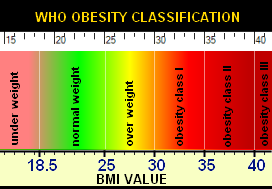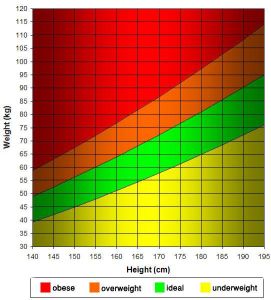
BMI, or body mass index, is an indirect measure of body fat in a person. Because the calculation only requires two pieces of information -- height and weight -- it is an inexpensive and easy method used to screen for weight categories that may lead to health problems such as diabetes, stroke, and heart disease. Calculating BMI can help determine if a person is overweight or obese; these calculations are often used in conjunction with other measurements (such as waist circumference) to assess a person's weight.
What Is BMI?
The UAE records one of the highest rates of obesity in the world, higher than the US. Over 100 million adult Americans are overweight or obese. Being overweight or obese increases a person's chances for developing serious health problems, especially heart disease, stroke, diabetes, and cancer. How does someone know if they are overweight or obese? Research on obesity has shown that a measurement called body mass index (or BMI for short) can be used to assess a person's level of body fat.
 BMI does not measure body fat directly, but it does correspond fairly closely to direct measures of body fat in most people. Therefore, it can be considered an alternative for direct measures of body fat. The number is determined using a person's height and weight. Because the calculation requires only height and weight, it is an inexpensive and easy-to-use method of screening for weight categories that may lead to health problems.
BMI does not measure body fat directly, but it does correspond fairly closely to direct measures of body fat in most people. Therefore, it can be considered an alternative for direct measures of body fat. The number is determined using a person's height and weight. Because the calculation requires only height and weight, it is an inexpensive and easy-to-use method of screening for weight categories that may lead to health problems.
How Is BMI Calculated?
There are a few ways to determine your body mass index:
- Calculate BMI using the BMI formula
- Use the BMI chart
- Use the BMI calculator.
Any of these three methods will get the same BMI result. Everyone can use one of these three methods regardless of age, gender, race, or ethnicity. There is no specific BMI chart for women or men.
Interpreting the Numbers
Once the BMI number is determined, it can be interpreted for adults using standard weight status categories that are the same for all ages and for both men and women. The standard weight status categories associated with BMI ranges for adults are shown below:

| BMI | Classification |
|---|---|
| < 18.5 | underweight |
| 18.5–24.9 | normal weight |
| 25.0–29.9 | overweight |
| 30.0–34.9 | class I obesity |
| 35.0–39.9 | class II obesity |
| >= 40.0 | class III obesity |
One criteria used to diagnose is a BMI under 17.5.
BMI and Weight
If someone has a high BMI, does that mean that they are overweight or obese? Furthermore, does that mean that they are at increased risk for health problems? The answers to both these questions depend on several factors.
BMI is just one factor to consider when assessing a person's weight. To determine if excess weight is a health risk, a healthcare provider will perform further assessments. According to recent guidelines, assessment of weight involves using three key measures:
- BMI
- Waist circumference
- Risk factors for diseases and conditions associated with obesity.
Keep in mind that the body mass index is a screening tool; it is not used to diagnose any medical conditions but instead is used as one measure to assess a person's weight and his or her risk for developing certain medical conditions.
High BMI and Medical Conditions
If someone is determined to be overweight or obese, they are at increased risk for certain medical conditions, including:
Other Ways to Measure Body Fatness
The BMI score is valid for both men and women, but it does have some limits. When it is used to calculate body fatness:
- It may overestimate body fat in athletes and others who have a muscular build.
- It may underestimate body fat in older people and others who have lost muscle mass.
Besides BMI, there are a number of different ways to measure body fatness. These other methods include:
- Skinfold thickness measurements (with calipers)
- Underwater weighing
- Bioelectrical impedance
- Dual-energy x-ray absorptiometry (DXA)
- Computerized tomography.
These other methods of measuring body fatness are more accurate than BMI. However, these methods are not always readily available, and they are either expensive or require highly trained personnel.
Healthy BMI and the United Arab Emirates
The UAE is working on a strategy to combat rising obesity rates and related health problems with the help of an international health organisation. The UAE records one of the highest rates of obesity in the world, higher than the US. It is blamed on a sedentary lifestyle and easy access to food high in fat and calories. It also has one of the highest rates of diabetes, one of many obesity-related diseases. Bad diet and lack of physical exercise were causing a wide range of health problems.
Nearly two-thirds of adults in the United States are overweight (defined as having a BMI equal to or greater than 25). This comes to about 130 million American adults. Nearly 61 million adults are obese (defined as a BMI greater than or equal to 30).
Even more concerning is that approximately 15 percent of children and adolescents are overweight and another 15 percent are at risk for being overweight (BMI for age between the 85th and 95th percentile). Child obesity is a growing concern in today's world. An alarming number of children are obese and developing diseases normally seen in adulthood.
Less than half of US adults have a healthy BMI. This is equivalent to about 68 million adults. About 37 million women between the ages of 20 and 74 have an ideal BMI. About 31 million men between the ages of 20 and 74 have an ideal BMI.
- High blood pressure (hypertension)
- Type 2 diabetes
- Heart disease
- High cholesterol or other lipid disorders
- Stroke
- Sleep apnea
- Osteoarthritis
- Certain cancers
- Gallbladder disease
- Fatty liver disease.
Even a small weight loss (just 5 to 10 percent of your current weight) will help to lower your risk of developing those diseases.
Calculating BMI
The only measurements you need to determine BMI are a person's height and weight. It is calculated the same way for adults and children, but the criteria for interpreting the outcomes are different. You can calculate BMI by using the simple formula explained in the following article. The version of the formula you use to determine BMI differs, depending on which system of measurement you're using.
Research on obesity has shown that body fat can be assessed using a calculation called body mass index, or BMI. BMI does not measure body fat directly, but it correlates closely to direct measures of body fat in most people.
The only measurements needed to calculate BMI are a person's height and weight. Because of this, BMI is an inexpensive and easy-to-use method of screening for weight categories that may lead to health problems
The Formula Used to Calculate BMI?
BMI is calculated the same way for adults and children. This calculation is based on the following formulas, depending on whether you are using the metric system or the English system.
(Use the BMI Calculator above for assessment of your BMI)
Metric System
The formula is:
Weight in kilograms divided by height in meters squared (weight (kg) / [height (m)2]).
Since height is commonly measured in centimeters, divide height in centimeters by 100 to obtain height in meters before you use the formula.
To calculate BMI, take the weight (kg) and divide it by height (m). Then divide that number once again by height (m). Round to the second decimal place.
An example of calculating BMI using the body mass index formula:
Height = 165 cm (1.65 m)
Weight = 68 kg
BMI Calculation: 68 ÷ (1.65)2 = 24.98
A Reminder About Using Adult BMI Criteria to Interpret BMI in Children
The adult BMI calculator provides only the BMI number and not the BMI age- and sex-specific percentile that is used to interpret body mass index and determine the weight category for children and teens. It is not appropriate to use the BMI weight status categories for adults to interpret numbers for children and teens.











